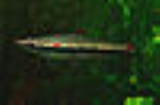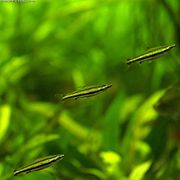
Nannostomus trifasciatus
Encyclopedia
Nannostomus trifasciatus, commonly known as the three-lined pencilfish, is a freshwater species
of fish
belonging to the genus
Nannostomus in the Lebiasinidae
family of Characins. They are popular in the aquarium
trade due to their small size, beautiful color pattern, and relative hardiness.
and, over the years, some of these color morphs have been erroneously described as separate species. 'Poecilobrycon erythrurus' and 'Poecilobrycon vittatus,' two such examples, are now known to be junior synonyms.
types. It has a broad distribution throughout the Amazon basin
, Colombia
, Peru
and the Guyanas
. In the Rio Negro, it inhabits the large swamp
s that form where tributaries meet the main branch of the river. When the river floods, it moves into the inundated rainforest
. During the low water season, it often becomes trapped in small lakes that are left behind, or stays close to the wooded edges of the forest. N. trifasciatus rests near the water surface at night and during the day inhabits the middle to upper water layers.
on pigment
cells in different regions of the integument. It has been suggested that the daytime color pattern may serve an aposematic or recognition function for individuals of the same species, and that the nighttime pattern may help hide the fish from nocturnal predators. In between the variable, darkly-pigmented regions, N. trifasciatus is greenish-gold in color on its back and sides and silver underneath. The gill cover and dorsal, pelvic, anal, and caudal fins possess red blotches, varying in size depending on the population. N. trifasciatus has often been confused in aquarium literature with N. marginatus which is also a three-striped pencilfish; however the latter species can be distinguished by its smaller size and blockier profile.
in this species is the least evident of the many species in the Nannostomus genus. The anal fin of males, which is often modified in shape or is more colorful in many Nannostomus species, is not modified or more colorful in N. trifasciatus. Males of the species may have an additional row of red spots in the gold area between the middle and uppermost stripes, but this is extremely variable even within populations. Males are sometimes slimmer and more colorful than females but, once again, this is very variable.
s. It is also an avid biofilm
grazer, ingesting microorganisms as well as algae
.
and other small-sized foods are indicated. Males will establish and defend small territories. The species spawn
s during the daytime among plant leaves. The eggs are adhesive and are most often placed on plants. Fertilization takes place externally, and anywhere from 30-100 eggs are produced at a time. The eggs hatch in 24-72 hours, depending on the water temperature. If well-fed, and if sufficient plant cover is provided, breeders will not eat eggs and fry will be found among floating plants. This species is seldom spawned in captivity and has never been commercially raised in fisheries. The aquarium trade relies exclusively on wild-caught specimens.

Species
In biology, a species is one of the basic units of biological classification and a taxonomic rank. A species is often defined as a group of organisms capable of interbreeding and producing fertile offspring. While in many cases this definition is adequate, more precise or differing measures are...
of fish
Fish
Fish are a paraphyletic group of organisms that consist of all gill-bearing aquatic vertebrate animals that lack limbs with digits. Included in this definition are the living hagfish, lampreys, and cartilaginous and bony fish, as well as various extinct related groups...
belonging to the genus
Genus
In biology, a genus is a low-level taxonomic rank used in the biological classification of living and fossil organisms, which is an example of definition by genus and differentia...
Nannostomus in the Lebiasinidae
Lebiasinidae
The Lebiasinidae , are a family of freshwater fishes found in Costa Rica, Panama, and South America. They are usually small and are known as ornamental fishes in aquaria, including popular fishes such as the pencil fish and splashing tetra.Lebiasinids are small, cylindrical fish, ranging from to ...
family of Characins. They are popular in the aquarium
Aquarium
An aquarium is a vivarium consisting of at least one transparent side in which water-dwelling plants or animals are kept. Fishkeepers use aquaria to keep fish, invertebrates, amphibians, marine mammals, turtles, and aquatic plants...
trade due to their small size, beautiful color pattern, and relative hardiness.
Taxonomy
Steindachner first described the species in 1876, making it one of the first four species in the genus to be described. As a result of the broad distribution of N. trifasciatus, the species is polymorphicPolymorphism (biology)
Polymorphism in biology occurs when two or more clearly different phenotypes exist in the same population of a species — in other words, the occurrence of more than one form or morph...
and, over the years, some of these color morphs have been erroneously described as separate species. 'Poecilobrycon erythrurus' and 'Poecilobrycon vittatus,' two such examples, are now known to be junior synonyms.
Distribution and habitat
N. trifasciatus prefers slow-moving, slightly acidic waters. Within these conditions, N. trifasciatus is found in several different habitatHabitat
* Habitat , a place where a species lives and grows*Human habitat, a place where humans live, work or play** Space habitat, a space station intended as a permanent settlement...
types. It has a broad distribution throughout the Amazon basin
Amazon Basin
The Amazon Basin is the part of South America drained by the Amazon River and its tributaries that drains an area of about , or roughly 40 percent of South America. The basin is located in the countries of Bolivia, Brazil, Colombia, Ecuador, Guyana, Peru, and Venezuela...
, Colombia
Colombia
Colombia, officially the Republic of Colombia , is a unitary constitutional republic comprising thirty-two departments. The country is located in northwestern South America, bordered to the east by Venezuela and Brazil; to the south by Ecuador and Peru; to the north by the Caribbean Sea; to the...
, Peru
Peru
Peru , officially the Republic of Peru , is a country in western South America. It is bordered on the north by Ecuador and Colombia, on the east by Brazil, on the southeast by Bolivia, on the south by Chile, and on the west by the Pacific Ocean....
and the Guyanas
Guyanas
Guyana is a country in South America.Guyana, Guayana, or Guiana may also refer to:*Guayana Esequiba, the territory of Guyana claimed by Venezuela*Guayana Region, an administrative region of Venezuela...
. In the Rio Negro, it inhabits the large swamp
Swamp
A swamp is a wetland with some flooding of large areas of land by shallow bodies of water. A swamp generally has a large number of hammocks, or dry-land protrusions, covered by aquatic vegetation, or vegetation that tolerates periodical inundation. The two main types of swamp are "true" or swamp...
s that form where tributaries meet the main branch of the river. When the river floods, it moves into the inundated rainforest
Rainforest
Rainforests are forests characterized by high rainfall, with definitions based on a minimum normal annual rainfall of 1750-2000 mm...
. During the low water season, it often becomes trapped in small lakes that are left behind, or stays close to the wooded edges of the forest. N. trifasciatus rests near the water surface at night and during the day inhabits the middle to upper water layers.
Description
The three-lined pencilfish is a small fish, with adults not reaching more than 6 cm in length. It has a small terminal mouth, and an adipose fin may or may not be present. Most pencilfish possess distinct daytime and nighttime color patterns, and N. trifasciatus is no exception. During the day, it has three black longitudinal stripes that run the length of the body. At night, three large dark spots materialize on the sides of the fish, extending from its back to its belly. Recent research has shown that this change in coloration is due to the differential action of the pineal hormone melatoninMelatonin
Melatonin , also known chemically as N-acetyl-5-methoxytryptamine, is a naturally occurring compound found in animals, plants, and microbes...
on pigment
Pigment
A pigment is a material that changes the color of reflected or transmitted light as the result of wavelength-selective absorption. This physical process differs from fluorescence, phosphorescence, and other forms of luminescence, in which a material emits light.Many materials selectively absorb...
cells in different regions of the integument. It has been suggested that the daytime color pattern may serve an aposematic or recognition function for individuals of the same species, and that the nighttime pattern may help hide the fish from nocturnal predators. In between the variable, darkly-pigmented regions, N. trifasciatus is greenish-gold in color on its back and sides and silver underneath. The gill cover and dorsal, pelvic, anal, and caudal fins possess red blotches, varying in size depending on the population. N. trifasciatus has often been confused in aquarium literature with N. marginatus which is also a three-striped pencilfish; however the latter species can be distinguished by its smaller size and blockier profile.
Sexual dimorphism
Sexual dimorphismSexual dimorphism
Sexual dimorphism is a phenotypic difference between males and females of the same species. Examples of such differences include differences in morphology, ornamentation, and behavior.-Examples:-Ornamentation / coloration:...
in this species is the least evident of the many species in the Nannostomus genus. The anal fin of males, which is often modified in shape or is more colorful in many Nannostomus species, is not modified or more colorful in N. trifasciatus. Males of the species may have an additional row of red spots in the gold area between the middle and uppermost stripes, but this is extremely variable even within populations. Males are sometimes slimmer and more colorful than females but, once again, this is very variable.
Diet
N. trifasciatus is omnivorous and spends much of its time near the water surface, where it feeds primarily on insectInsect
Insects are a class of living creatures within the arthropods that have a chitinous exoskeleton, a three-part body , three pairs of jointed legs, compound eyes, and two antennae...
s. It is also an avid biofilm
Biofilm
A biofilm is an aggregate of microorganisms in which cells adhere to each other on a surface. These adherent cells are frequently embedded within a self-produced matrix of extracellular polymeric substance...
grazer, ingesting microorganisms as well as algae
Algae
Algae are a large and diverse group of simple, typically autotrophic organisms, ranging from unicellular to multicellular forms, such as the giant kelps that grow to 65 meters in length. They are photosynthetic like plants, and "simple" because their tissues are not organized into the many...
.
In the aquarium
N. trifasciatus is a popular and appropriate community aquarium species, if tankmates are of similar size and demeanor, and will thrive if kept in soft, mildly acidic water at temperatures between 72F and 82F. Baby brine shrimpBrine shrimp
Artemia is a genus of aquatic crustaceans known as brine shrimp. Artemia, the only genus in the family Artemiidae, has changed little externally since the Triassic period...
and other small-sized foods are indicated. Males will establish and defend small territories. The species spawn
Spawn (biology)
Spawn refers to the eggs and sperm released or deposited, usually into water, by aquatic animals. As a verb, spawn refers to the process of releasing the eggs and sperm, also called spawning...
s during the daytime among plant leaves. The eggs are adhesive and are most often placed on plants. Fertilization takes place externally, and anywhere from 30-100 eggs are produced at a time. The eggs hatch in 24-72 hours, depending on the water temperature. If well-fed, and if sufficient plant cover is provided, breeders will not eat eggs and fry will be found among floating plants. This species is seldom spawned in captivity and has never been commercially raised in fisheries. The aquarium trade relies exclusively on wild-caught specimens.


